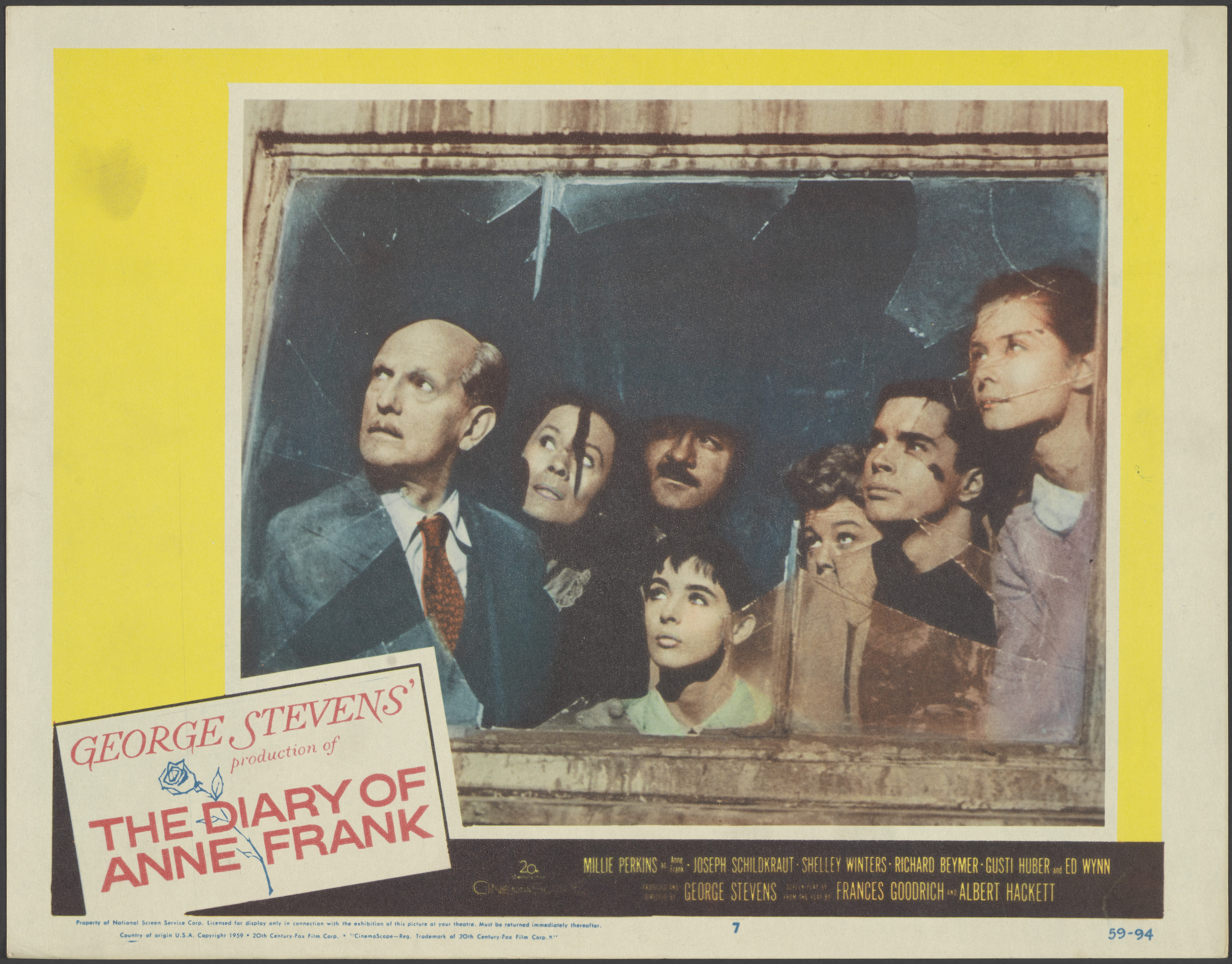Otto Frank and the film 'The Diary of Anne Frank'
In 1959, the American film adaptation of Anne Frank's diary was released in cinemas.

Affiche speelfilm
Fotograaf: Studio Buitenhof. Collectie: Anne Frank Stichting.
In the contract with Contact Publishers (1946) on the publication of the diary, Otto Frank had explicitly included that he retained the translation and film rights to the diary.[1]
American writer/journalist Meyer Levin was convinced of the potential for a stage and/or film adaptation of the diary after reading the diary in its French translation (September 1950).[2] Otto Frank, on the other hand, was not so sure of this:
' As far as the film is concerned I am a layman and cannot imagine a good solution to bring out the thoughts and ideas. I am afraid that the exciting and thrilling actions would prevail, to please the public. But if you see it in another way just go on and I shall not interfere. It even would be possible to film the original place and I would try my best to overcome my inner feelings. '[3]
With Otto Frank's permission, Meyer Levin tried unsuccessfully to establish contacts with film producers.[4] Only after the diary's success in the United States did theatre and film producers show interest. For instance, according to Otto Frank, the American publisher Doubleday received daily requests for film, radio and television adaptations.[5] Otto Frank saw more in a film adaptation independent of the play and did not think 'that Hollywood would be the right sphere'. [6]
When Cheryl Crawford threatened to withdraw as producer of the play, and before there was an agreement with producer Kermit Bloomgarden, Otto Frank briefly considered stopping the stage adaptation and starting negotiations on a film adaptation, for which there was sufficient interest.[7]
But when Italian producers and directors showed interest in the film adaptation after the Italian translation appeared in the summer of 1954, Otto Frank decided that, as long as there was no stage play, he still thought it was too premature. [8]
Later, Otto Frank agreed with producer Kermit Bloomgarden and the Hacketts, the play's writers, not to negotiate film rights with third parties before the play's premiere on Broadway in New York on 5 October 1955.[9] After the try-outs in Philadelphia and the premiere, there were negotiations with several film companies.[10]
On 30 April 1957, Otto Frank and the Hacketts signed a contract with Twentieth Century Fox for the film adaptation based on the English and American editions of the diary in Barbara Mooyaart's translation.[11] The US premiere of the film The Diary of Anne Frank, directed by George Stevens, was on 18 March 1959. The Dutch premiere followed on 16 April 1959.[12]
Auguste van Pels' sister, Greta Goldsmith, reacted angrily to the film:
'Ich hoerte schon durch Anni v. Pels, durch Ida und mehrere andere Familiemitglieder von der wenig sympathischen Rolle, die "Schwager Hermann" drin spielte. (...) ich war entzetst, dass Sie so etwas erlaubt haben, dass Sie werter Otto Frank sich nicht dagegen gewehrt haben. (...) (aber musste man eine "Streicherfigur" wählen????) \u2014 und somit einem Menschen, der schon durch seinen fuertlichen Tod im Konzentrtionslager so best punished worden ist, derartig verunglimpfen??????? '
In the same letter, Greta Goldschmith suggested that Otto Frank publish a tribute to her brother-in-law Hermann van Pels in the German emigrant magazine Aufbau.[13] No sources are known to indicate that this actually happened.
After seeing the Dutch premiere - with a reception attended by Queen Juliana - Miep Gies, Bep van Wijk-Voskuijl and Joke Kleiman (now the widow of Johannes Kleiman) wrote to Otto with their thoughts on the film. [14]
Footnotes
- ^ Anne Frank Stichting (AFS), Anne Frank Collectie (AFC), Otto Frank Archief (OFA), reg. code OFA_089: Correspondentie van Otto Frank met Uitgeverij Contact, augustus-september 1946.
- ^ AFS, AFC, OFA reg.code_59, Meyer Levin aan Otto Frank, 10 maart 1951. [MM745C-300043_168]
- ^ AFS, AFC, reg. code OFA_159: Otto Frank aan Meyer Levin, 29 september 1950.
- ^ AFS, AFC, reg. code OFA_159: Correspondentie van Otto Frank met Meyer Levin, 1950-1952.
- ^ AFS, AFC, reg. code OFA_132: Otto Frank aan Japp (Vallentine Mitchell and Co.), 19 juli 1952. Zie ook: AFS, AFC, reg. code OFA_171: Meyer Mermin aan Otto Frank, 28 februari 1953.
- ^ AFS, AFC, reg. code OFA_132: Meyer Mermin aan Otto Frank, 11 augustus 1952.
- ^ AFS, AFC, reg. code OFA_171: Correspondentie van Otto Frank met Meyer Mermin, januari-juni 1953.
- ^ AFS, AFC, reg. code OFA_202: Correspondentie van Otto Frank met Meyer Mermin, 2-14 juni 1954.
- ^ AFS, AFC, reg. code OFA_202: Otto Frank aan Praesens-Film AG, 23 mei 1955.
- ^ Zie o.a.: AFS, AFC, reg. code OFA_202: Correspondentie van Calvin L. Fox met Otto Frank, 1 en 5 november 1955.
- ^ AFS, AFC, reg. code OFA_202: Contract Otto Frank, Frances Goodrich en Albert Hackett met Twentieth Century Fox.
- ^ AFS, AFC, B_film_I_003: toegangsbewijs Europese filmpremiere 20th Century Fox, 16 april 1959.
- ^ AFS, AFC, reg. code OFA_076: Grete Goldschmidt aan Otto Frank, 16 mei 1959.
- ^ AFS, AFC, reg. code OFA_81: Elly van Wijk-Voskuijl aan Otto Frank, 19 april 1959, Joke Kleiman aan Otto Frank, 20 april 1959, Miep Gies aan Otto Frank, 21 april 1959.